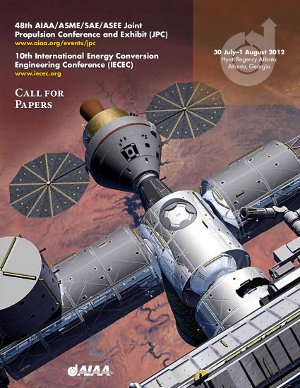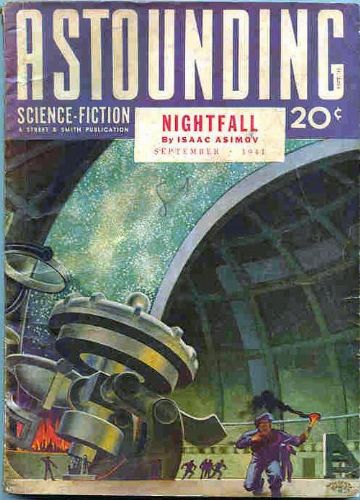Centauri Dreams
Imagining and Planning Interstellar Exploration
Dying Stars and their Planets
Although I can’t make the journey just then, I wish I could attend an upcoming conference at Arecibo (Puerto Rico) called Planets around Stellar Remnants. The meeting takes place twenty years after the discovery of the first exoplanets, the worlds orbiting the millisecond pulsar PSR B1257+12. I’ve been interested in the fate of planets around older stars ever since reading H.G. Wells’ The Time Machine as a boy and encountering his image of a swollen, dying Sun. We also have interesting questions to ask about the kind of planets that exist around white dwarfs, and whether new planets (and chances for life) may eventually occur in their systems.
It’s appropriate that the conference be organized by Penn State, for it was that university’s Alexander Wolszczan, working with Dale Frail of the National Radio Astronomy Observatory, who made the discovery of those two and possibly three planets that launched the modern exoplanet era. Nor has Wolszczan slowed in his efforts. The most recent work out of Penn State is the discovery of planets around three dying stars — HD 240237, BD +48 738, and HD 96127 — one of which has an interesting and still unidentified object, perhaps a brown dwarf, in orbit around it.
All three of the stars are much further along in their lifelines than our Sun, says Wolszczan:
“Each of the three stars is swelling and has already become a red giant — a dying star that soon will gobble up any planet that happens to be orbiting too close to it. While we certainly can expect a similar fate for our own Sun, which eventually will become a red giant and possibly will consume our Earth, we won’t have to worry about it happening for another 5 billion years.”
What we get by studying highly evolved stars like these is an updated window into planet formation. 30 known planets and brown dwarf-mass companions are now known to exist around giant stars (all three stars studied here are K-class giants). The object around BD +48 738 is tricky because a long-term radial velocity trend here indicates a distant companion but the data are not yet sufficient to decide between a planet and a low-mass star as the culprit. The star is also orbited by a planet of about 90 percent Jupiter’s mass at roughly 1 AU in a 400-day orbit.
I’ll pause on this because we’re finding a number of companions to giant stars that have minimum masses of about 10 Jupiter masses, making them either brown dwarf candidates or massive planets. It will take further work to identify the object in the outer system of BD +48 738, but if it does turn out to be a brown dwarf, then we have another case of a system with a Jupiter-class inner planet and a distant brown dwarf orbiting the same star. The paper on this work discusses the implications in terms of our primary theories of planet formation:
In principle, such a system could form from a sufficiently massive protoplanetary disk by means of the standard core accretion mechanism (Ida & Lin 2004), with the outer companion having more time than the inner one to accumulate a brown dwarf like mass. A more exotic scenario could be envisioned, in which the inner planet forms in the standard manner, while the outer companion arises from a gravitational instability in the circumstellar disk at the time of the star formation (e.g. Kraus et al. 2011). In any case, it is quite clear that this detection, together with the other ones mentioned above, further emphasizes the possibility that a clear distinction between giant planets and brown dwarfs may be difficult to make…
The three stars appear jittery under observation because they oscillate more than younger stars like the Sun. That made the planet hunt a challenge, but also allowed for the discovery of a negative correlation between the star’s metallicity and the degree to which it oscillates. Wolszczan says that the less metal content the team found in each star, the more noisy and jittery it turned out to be. The paper relates this to p-mode (pressure-driven) oscillations at the surface of the star:
The origin of this trend is most likely related to the fact that higher metallicity (opacity) of the star lowers its temperature, which decreases the amplitude of p-mode oscillations, while lower metallicity has the opposite effect.
This Penn state news release quotes Wolszczan on the future of our own Solar System as the Sun swells to become a red giant and swallows the inner planets. Somewhere in the remote future, says the astronomer, perhaps one to three billion years from now, we may consider moving to Europa, an icy wasteland that under the gaze of a swollen Sun will become a world of ‘vast, beautiful oceans.’ It’s an enchanting thought, and one we’ll doubtless think more about as we continue our investigations of giant stars and the fate of planetary systems around them.
The paper is Gettel et al., “Substellar-Mass Companions to the K-Giants HD 240237, BD +48 738 and HD 96127,” accepted by the Astrophysical Journal (preprint).

Notes & Queries 11/2/11
Tau Zero in Second Life
I have almost no experience with online virtual worlds like Second Life, but I do want to mention that Marc Millis will appear later today (Nov. 2) on the ‘Virtually Speaking’ talk show program, which can be accessed here as well as in Second Life. The focus of the interview is to be on prospects for interstellar travel, what a program like the 100-Year Starship can do, and what Tau Zero and other efforts (such as Project Icarus) are all about. The show begins at 9 PM Eastern time (0200 UTC) this evening, and may wind up being audio-only if the Second Life bit doesn’t work out.
I’m sure it will, but Marc is as new to Second Life as I am, and my last experience with the medium had me wandering around in an enormous virtual house trying to find someone with whom I was supposed to be doing an online interview, and I remember being alternately intrigued and baffled by the options available to me. Old time Second Lifers will find this bizarre, I’m sure, but some of us haven’t yet gotten up to speed with meetings held in virtual worlds, alas.
A Conference on Olaf Stapledon
Be aware of Starmaker: The Philosophy of Olaf Stapledon, a conference to be held at the headquarters of the British Interplanetary Society at 27/29 South Lambeth Road, London on November 23. Born in 1886, Williams Olaf Stapledon was a philosopher by training and a writer by choice, the author of two classics that have had a powerful impact on many scientists now working in aerospace and interstellar studies: Last and First Men (1930) and Star Maker (1937). You may also have heard of Odd John (1935), although it should be noted that Stapledon was prolific at both fiction and non-fiction.

Image: Stapledon lecturing at the British Interplanetary Society, to which he had been invited by Arthur C. Clarke in 1948.
The complete program is online, and among the presentations I note in particular Richard Osborne’s talk on Stapledon and Dyson spheres. Freeman Dyson is on record as saying that it was Stapledon’s futuristic vision in Star Maker that brought about the concept of Dyson spheres, hardly the first instance of this author’s influence. When Stapledon lectured at the BIS, his topic was ‘Interplanetary Man,’ but his vision reached far deeper into the cosmos than our own Solar System, dealing with themes of consciousness and the survival of intelligence in an evolving universe.
The Alpha Centauri Prize
Project Icarus founder Kelvin Long has gone online with a proposal for an international competition to promote research on the design of a star probe. Long is thinking in terms not dissimilar from the X Prize, though the Alpha Centauri Prize he advocates would be considered an extension of the existing Project Icarus and long-term in nature.
Over time, the concept would be worked upon by future generations and ultimately lead to a direct design blue print for an interstellar probe after several decades of running. Like Project Icarus, it is the hope that other teams around the world would be assembled to work on specific proposals investigated historically such as NERVA, Starwisp, Vista, Longshot, AIMStar, Orion or one of the many others. This way, the technological maturity of different propulsion schemes can be improved over time and the case could be better made for precursor missions to the outer solar system and one day to the nearest stars.
Long envisions teams competing for a cash prize every two to three years in an academic competition run by a non-profit organization. Over time, engineering design ideas for a probe to another star would evolve. The process is a gradual one that may not settle upon a single optimum propulsion method:
… we may find that what may emerge is not a single choice for going to the stars in the coming centuries, but instead a realization that it is a combination of approaches with highly optimized engineering designs that will be the way to go. This may suggest hybrid propulsion schemes and could for example be along the lines of a fusion-based drive with anti-proton catalyzed reactions but using a nuclear electric engine for supplementary power and perhaps a solar sail and MagSail for solar system escape or upon arrival. From the two decades of research will develop reliable engineering studies, practical progress of the technology and several clear front runner designs to focus initially divergent research options towards the proper investment into the clear front runner designs by a process of gradual down select.
Can an Alpha Centauri Prize be a serious incentive for research and an enabler for new technologies, as well as a driver for inspiring students and educating the public? More on the idea in The Alpha Centauri Prize: Taking Volunteer Research To A New Level.
Propulsion Conference Abstract Deadline
On 30 July to 1 August, 2012 the 48th AIAA/ASME/SAE/ASEE Joint Propulsion Conference & Exhibit takes place in Atlanta. The focus is broad, as the AIAA comments on its site:
The objective for JPC 2012 is to identify and highlight how innovative aerospace propulsion technologies powering both new and evolving systems are being designed, tested, and flown. Flight applications include next generation commercial aircraft, regional, and business jets, military applications, supersonic/hypersonic high speed propulsion applications, commercial and government-sponsored launch systems, orbital insertion, satellite, and interstellar propulsion.
Next summer seems a long way off as the weather changes toward late fall in the northern hemisphere, but I mention this now because abstracts for the conference are due by November 21. You can view the call for papers here.
Upcoming Interstellar Workshop
Finally, be aware of the Tennessee Valley Interstellar Workshop, running November 28 & 29, 2011 in Oak Ridge, TN at the Doubletree Hilton Hotel. Here’s the agenda for Tuesday the 29th, following an opening reception the night before:
8:00 Welcome and Opening Remarks (Les Johnson)
8:15 Sun Focus Comes First; Interstellar Comes Second (Dr. Claudio Maccone)
9:00 Interstellar Travel: Realistic Ideas and Fanciful Dreams (Les Johnson)
9:30 Human and Institutional Barriers to Large Scale Scale Geoengineering and Interstellar Spaceflight (Dr. Kent Williams)
10:00 Coffee Break and Group Picture
10:30 Power and Propulsion: An Informal Survey of Opportunities Within Particle Physics (Dr. Jim Woosely)
11:00 Project Icarus (Dr. Richard Obousy)
11:30 Antimatter Propulsion (Harold Gerrish)??
12:00 Lunch
1:00 Interstellar Light Sails (Dr. Gregory Matloff)
1:30 TBD (Dr. Conley Powell)
2:00 Jovian Tesla Radio (Dr. David Fields)
2:30 Lasers Revisited: Their Superior Utility for Interstellar Beacons, Communications and Travel (Dr. John Rather)
3:00 Interstellar Exploration Through Art (C Bangs)
3:30 Humanity in the Outlands: Anthropological and Sociological Concerns in the Face of Touching the Universe? (Dr. Robert C. Lightfoot)
4:00 Shell Worlds (Robert Kennedy)?
4:30 Sublight Colonization of the Galaxy (Ken Roy)?
5:00 The Fermi Paradox: A Roundtable Discussion (Stephanie Osborn)
6:00 Dinner
8:00 Public Forum (Robert Kennedy)

The Fate of Planets Near Galactic Center
?It was Gregory Benford who used the wonderful phrase ‘the first hard science fiction convention’ to describe what happened at the 100 Year Starship Symposium. It was an apt choice of words. ‘Hard’ science fiction refers to SF that goes out of its way to get the science right, and in which the scientific and technical details play a major role in the development of the plot. Science fiction critic P. Schuyler Miller evidently coined the term in one of his reviews for Astounding Science Fiction back in the 1950s. In many ways, the Symposium operated under a science fictional meme.
Science fiction at its best exists to paint possibilities for us. Some scientific speculations may be remarkable in their own right but only become vivid when portrayed by writers who can make the background science into a scenario that plays out in fictional terms. An obvious case is the classic Isaac Asimov tale “Nightfall,” published in Astounding’s September, 1941 issue. Asimov took us to a place that knew night only once every 2000 years because of the configuration of the six suns in its planetary system. His craft painted a world few would have imagined, and showed us the consequences of its existence upon a civilization there.
All these musings were triggered by the latest news from the University of Leicester, and I’d love to see the science fiction story that might emerge when ‘hard’ SF tackles its findings. Surely someone will tell the story of a civilization too close to galactic center (speaking of places that are well lit!), and the consequences as radiation levels begin to rise to untenable levels on a world too near the central black hole. If interstellar flight is possible, surely it would happen here as a means of species survival.
For black holes seem to be common at galactic center in many galaxies, and in particular the supermassive ones that lurk at the center of galaxies like our Milky Way. Huge cloaks of dust obscure many of these, and a team of scientists led by Sergei Nayakshin at Leicester thinks that collisions between planets and asteroids occurring at speeds up to 1000 kilometers per second could be the cause. Nayakshin’s team argues that the accretion disc around supermassive black holes will eventually form planets, and that planets and asteroids that formed in the outer regions of the disc would be stripped away by the close passage of stars in the disc, given the tight quarters at galactic center.
From the paper:
Released from their host stars, these solids and planets orbit the SMBH independently. Since the velocity kick required to unbind them from the host is in km/s range, whereas the star’s orbital velocity around the SMBH is ? 1000 km/s, orbits of the solids are initially only slightly different from that of their hosts. AGN gas discs are expected to be very geometrically thin (e.g., Nayakshin & Cuadra 2005), and if they always lay in the same plane (e.g., the disc galaxy’s mid-plane) then the resulting distribution of solids would be quite thin and planar as well.
So far so good, but planets in this scenario seem bound to come to grief:
However, there is no particularly compelling reason for a single-plane mode of accretion in AGN as the inner parsec is such a tiny region compared with the rest of the bulge (Nayakshin & King 2007), and chaotically-oriented accretion may be much more likely…
Collisions are bad enough, but the planets would have already been sterilized as they orbited the supermassive black holes, says Nayakshin in a related news release:
“Too bad for life on these planets, but on the other hand the dust created in this way blocks much of the harmful radiation from reaching the rest of the host galaxy. This in turn may make it easier for life to prosper elsewhere in the rest of the central region of the galaxy.”
The team takes its lead from the zodiacal dust in our own Solar System, known to be the result of collisions between solid objects like asteroids and comets. And its work may help us understand how black holes grow and affect the galaxies within which they reside. The dust and gas in the inner regions of our own galaxy, much of which might have been expelled or destroyed by this process, would otherwise have contributed to the formation of more stars and planets. The black hole at galactic center would have thus played a significant role in the evolution of the Milky Way.
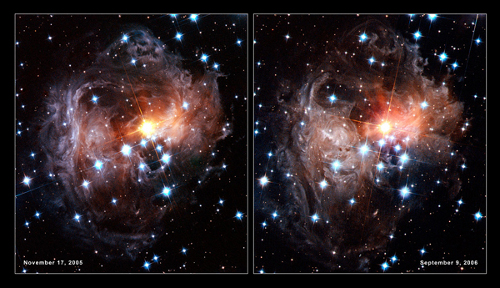
Image: ‘Light echo’ of dust illuminated by a nearby star V838 Monocerotis as it became 600,000 times more luminous than our Sun in January 2002. The flash is believed to have been caused by a giant collision of some kind, e.g., between two stars or a star and a planet. Collisions of smaller objects, such as asteroids or minor planets near a supermassive black hole could also be dramatic due to the huge collision velocities and would release a lot of dust. Credit: NASA/ESA.
The paper is Nayakshin, et al., “Are SMBHs shrouded by ‘Super-Oort’ clouds of comets and asteroids?” in press at Monthly Notices of the Royal Astronomical Society (preprint). The science fiction story based on it remains to be written.

Widening the Red Dwarf Habitable Zone
Long-time Centauri Dreams readers will be familiar with the work of Manoj Joshi and Robert Haberle. Back in the 1990s when both were at NASA Ames (Joshi is now at the University of Reading), the scientists went to work on the question of whether planets around red dwarf stars could be habitable, given the problem of close orbits and tidal lock. Simulating the atmosphere of such a planet, they found even a thin atmosphere would circulate globally, moving enough heat to prevent the air on the darkside from freezing out. The prospect of a planet with oceans and a climate mild enough to support life began to look more promising.
Joshi and Haberle have a new paper out that looks once again at planets around red dwarfs, this time extending the possible habitable zone to a greater distance from the star. M-class red dwarfs are smaller and cooler than G-class stars like the Sun, and emit a much larger fraction of their radiation at longer wavelengths where the reflectivity of ice and snow are lower. The effect is striking, as the paper notes:
The values for snow and ice for a planetary surface orbiting the Sun are 0.8 and 0.5 respectively, which are broadly consistent with the values that are used in climate models. Fresh snow and ice albedos on a planet receiving black body radiation from an object at 3300K are 0.6 and 0.3 respectively, which are significant reductions from the “solar” values.
The black body radiation is an idealised representation of an M-dwarf that is approximately 40% as massive as the Sun. The authors then go on to calculate the albedos for snow and ice on hypothetical planetary surfaces around the stars Gliese 436 and GJ 1214 and find them even lower. What this means is that more of the long-wave radiation emitted by an M-dwarf will be absorbed rather than reflected by an icy surface. The effect is to widen the habitable zone of a planet around this kind of star outwards by anywhere from 10 to 30 percent. What might have seemed a frigid world now looks more hospitable.
Allowing a habitable zone (defined here in terms of liquid water at the surface) to exist farther out from the parent star is significant, although there are no changes at the other end of the HZ:
The effect considered here should not move the inner edge of the habitable zone, usually considered as the locus of orbits where loss rates of water become significant to dry a planet on geological timescales (Kasting et al 1993), away from the parent M-star. This is because when a planet is at the inner edge of the habitable zone, surface temperatures should be high enough to ensure that ice cover is small. For a tidally locked planet this implies that ice is confined to the dark side that perpetually faces away from the parent star: such ice receives no stellar radiation, rendering albedo effects unimportant.
But planets with significant amounts of snow and ice will have higher surface temperatures and the outer edge of the habitable zone is extended. It’s an interesting thought because of the sheer ubiquity of red dwarfs — some estimates of their prevalence run as high as 80 percent of main-sequence stars, so seeing them as astrobiologically friendly would revise our estimates for extraterrestrial life. Just how close the nearest life-bearing planet might be affects our planet hunt astronomically as we choose targets and has significance for any future interstellar probes.
Other issues remain and are under active investigation, from the problem of flares to climate models involving the effects of clouds and water vapor. A good place to get an overview is Tarter et al., “A Reappraisal of The Habitability of Planets around M Dwarf Stars,” Astrobiology 7, pp 30-65 (2007). The Joshi and Haberle paper is “Suppression of the water ice and snow albedo feedback on planets orbiting red dwarf stars and the subsequent widening of the habitable zone,” accepted by Astrobiology (preprint).

A Surprise at Lutetia
?Sometimes our spacecraft take us past an asteroid, and other times the asteroid comes to us. Asteroid 2005 YU55 pays Earth a visit soon, closing to a bit less than the distance of the Moon on November 8. The Deep Space Network dish at Goldstone (CA) and the Arecibo facility in Puerto Rico will track the object, with images from Goldstone expected to achieve resolutions as fine as 2 meters per pixel, which should give us a wealth of information about the asteroid’s surface features. About the size of an aircraft carrier, 2005 YU55 was also observed by Arecibo in 2010, when it was found to be roughly spherical in shape with a rotation period of 18 hours.
You’ll also recall asteroid 21 Lutetia, which we covered here when the European Space Agency’s Rosetta probe flew past it in July of 2010. The imagery from that encounter showed a cracked and battered surface, but new analysis now indicates that the asteroid may once have had a hot metallic core. Lutetia may, in other words, be a remnant of an ancient period of planetary formation.
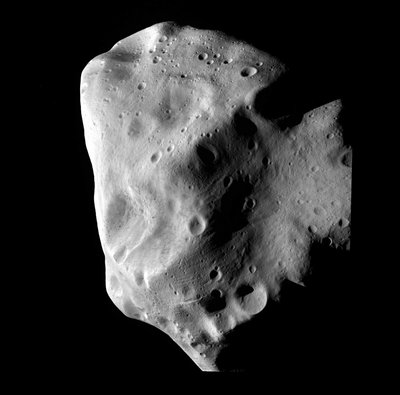
This is interesting stuff because most objects in the main belt between Mars and Jupiter are thought to be relatively light masses of rock and metal that have battered each other for billions of years. Few would have melted to form metallic cores, so the thinking goes, and most would be little more than loosely bound piles of debris. But Holger Sierks (Max-Planck Institute for Solar System Research) and the Rosetta team find that Lutetia is actually quite dense. They based their work on calculations of the asteroid’s volume and mass, drawing on models derived from the Rosetta images and the effect of Lutetia’s gravity on the spacecraft.
Image: A year after the flyby, the analysis shows that Lutetia is a primordial asteroid, with a surface covered in craters, pulverised rocks and landslides. It may also have tried to form an iron core billions of years ago. Credit: ESA 2010 MPS for OSIRIS Team MPS/UPD/LAM/IAA/RSSD/INTA/UPM/DASP/IDA.
The Sierks paper on this work puts the matter succinctly:
[Lutetia’s] geologically complex surface, ancient surface age, and high density suggest that Lutetia is most likely a primordial planetesimal. This contrasts with smaller asteroids visited by previous spacecraft, which are probably shattered bodies, fragments of larger parents, or reaccumulated rubble piles.
Look at the surface of Lutetia and you see huge fractures that suggest a porous object that does not square with the density calculations. But Benjamin Weiss (MIT) suggests that melted material beneath the fractured crust — a dense metallic core — would account for the discrepancy. And instead of the idea of asteroids as primordial unmelted objects, we begin to see a boundary line, with the possibility of larger asteroids being partially differentiated, possessing a melted interior overlain by outer layers. Here’s Weiss on the subject:
“The planets don’t retain a record of these early differentiation processes. So this asteroid may be a relic of the first events of melting in a body.”
That would make asteroids like Lutetia unusual but not unique — there may be many objects with unmmelted surfaces but differentiated interiors. The challenge will be to get to an asteroid to return samples that could provide more evidence for this explanation. The smallest asteroids are unlikely to retain a molten interior, but larger bodies in the asteroid belt may prove more interesting than we had realized.
At the time of the 2010 encounter, Lutetia was the largest asteroid ever to have been visited by a spacecraft. Vesta has now eclipsed that record, and the recent findings will make Dawn’s missions at Vesta and Ceres all the more interesting. An asteroid sample return mission — Weiss is part of the NASA team — is slated for a 2016 launch, though not to Lutetia. It’s interesting to note here that earlier work by Weiss on the Allende meteorite showed that samples were strongly magnetized, leading to the theory that the meteorite came from an asteroid with a melted metallic core. All of this may be showing us planetary development in its earliest stages.
The papers are Sierks et al., “Images of Asteroid 21 Lutetia: A Remnant Planetesimal from the Early Solar System,” Science Vol. 334 no. 6055, pp. 487-490 (28 October 2011), abstract available. See also Pätzold et al., “Asteroid 21 Lutetia: Low Mass, High Density,” Science Vol. 334 no. 6055, pp. 491-492 (28 October 2011) — abstract — and Coradini et al., “The Surface Composition and Temperature of Asteroid 21 Lutetia As Observed by Rosetta/VIRTIS,” Science Vol. 334 no. 6055, pp. 492-494 (28 October 2011), abstract available. Weiss’ paper on differentiation is Weiss et al., “Possible evidence for partial differentiation of asteroid Lutetia from Rosetta,” Planetary and Space Science, in press, available online 8 October 2011 (abstract).

New Findings on Eris
Back when I was writing my Centauri Dreams book in 2004, I remember talking to JPL’s James Lesh about various aspects of communicating with distant spacecraft. Lesh had written an interesting paper on how we might communicate with an Alpha Centauri probe, and we went on to discuss laser communications in the context of today’s Deep Space Network. What stuck in my mind about that conversation was how much we can learn when one thing moves in front of another. Lesh pointed out how useful it is to examine a radio signal when a spacecraft moves behind a planet, studying the attenuation of the signal and learning more about the planet itself.
When a celestial object moves in front of a distant star, we also get useful results, as has recently happened in our studies of the dwarf planet Eris. You’ll recall that it was Eris that kicked off a new round of controversy about Pluto, for the early estimates were that the diameter of Eris (then thought to be 3000 kilometers) was actually 25 percent larger than Pluto’s. The possibility of numerous such objects in the Kuiper Belt caused us to reassess the definition of the word ‘planet,’ leading to the creation of ‘dwarf planet’ as the operative term for both Eris and Pluto.
But in November of last year, Eris occulted a distant star, an event monitored at two sites in Chile, including the TRAPPIST (TRAnsiting Planets and PlanetesImals Small Telescope) at La Silla. We learn from this that Eris is close to spherical, assuming there are no large mountains on the object, and that Pluto and Eris are more or less the same size, with the new diameter calculated for Eris coming in at 2326 kilometers (Pluto’s is between 2300 and 2400 kilometers). It’s interesting that Pluto’s diameter is actually harder to measure because even with the help of past occultations, the presence of an atmosphere makes the measurement less precise.
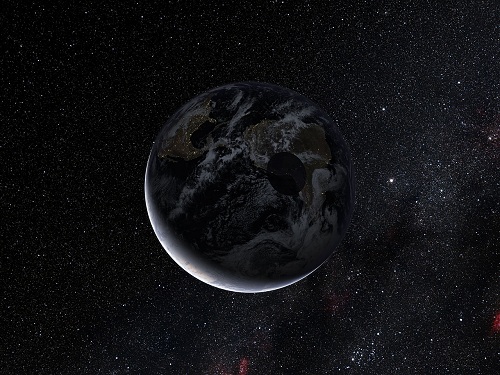
Image: This artist’s impression shows the shadow of the dwarf planet Eris as it was crossing the Earth during the occultation in November of 2010. The regions along the path saw a faint star briefly disappear as its light was blocked by Eris. Studies of where the event was seen, and for how long, have allowed astronomers to measure the size of Eris accurately for the first time. Surprisingly, they find it to be almost exactly the same size as Pluto and learn that it has a very reflective surface. Credit: ESO/L. Calçada.
Eris turns out to be reflective indeed, with an albedo of 0.96 (reflecting some 96 percent of the light that falls on it). This ESO news release notes that this albedo makes the dwarf planet brighter than fresh snow on Earth, flagging it as one of the most reflective objects in the Solar System, in company with Saturn’s moon Enceladus. Moreover, studies of Eris’ moon Dysnomia help us arrive at a mass estimate for Eris, which turns out to be 27 percent heavier than Pluto, with a density estimated at 2.52 grams per cubic centimeter. Emmanuel Jehin, one of the researchers involved in the occultation study, says this about the finding:
“This density means that Eris is probably a large rocky body covered in a relatively thin mantle of ice. This layer of ice could result from the dwarf planet’s nitrogen or methane atmosphere condensing as frost onto its surface as it moves away from the Sun in its elongated orbit and into an increasingly cold environment.”
Estimates suggest a surface temperature of -238 Celsius on the day side of Eris, but when the object moves back toward perihelion in its orbit (37.8 AU), the ice Jehin is talking about may well turn back into gas. Eris is currently at 96.6 AU, near aphelion. Telescopes at 26 different locations around the globe were used to observe the occultation, but the dwarf planet’s shadow was only detected at the two sites in Chile, where a sudden drop in brightness was apparent. But even with small telescopes, the value of one celestial object moving in front of another is again demonstrated, helping us learn more about a dwarf planet on the edge of the Solar System.
The paper is Sicardy et al., “A Pluto-like radius and a high albedo for the dwarf planet Eris from an occultation,” Nature 478, 493-496 (27 October 2011). Abstract available.

